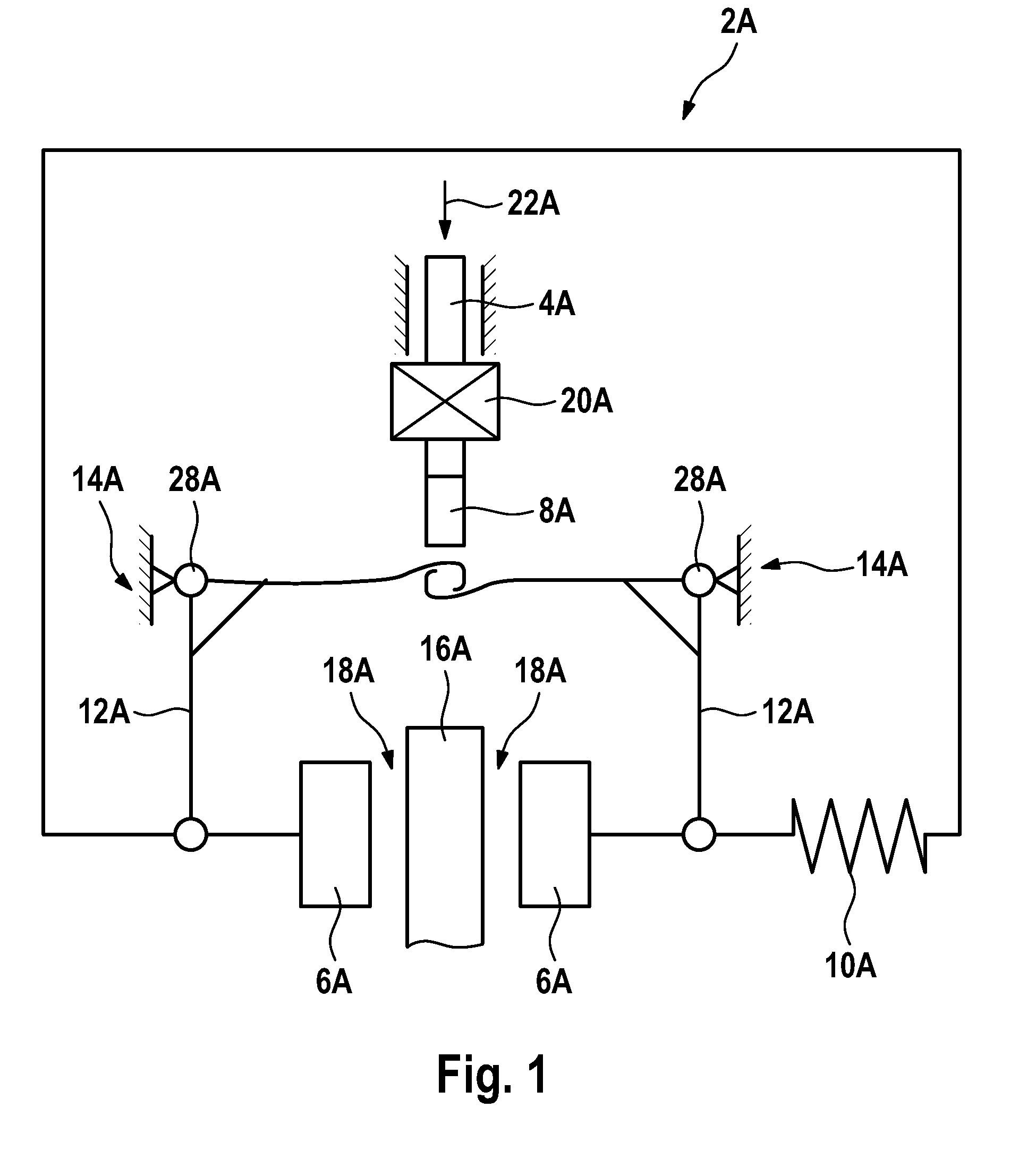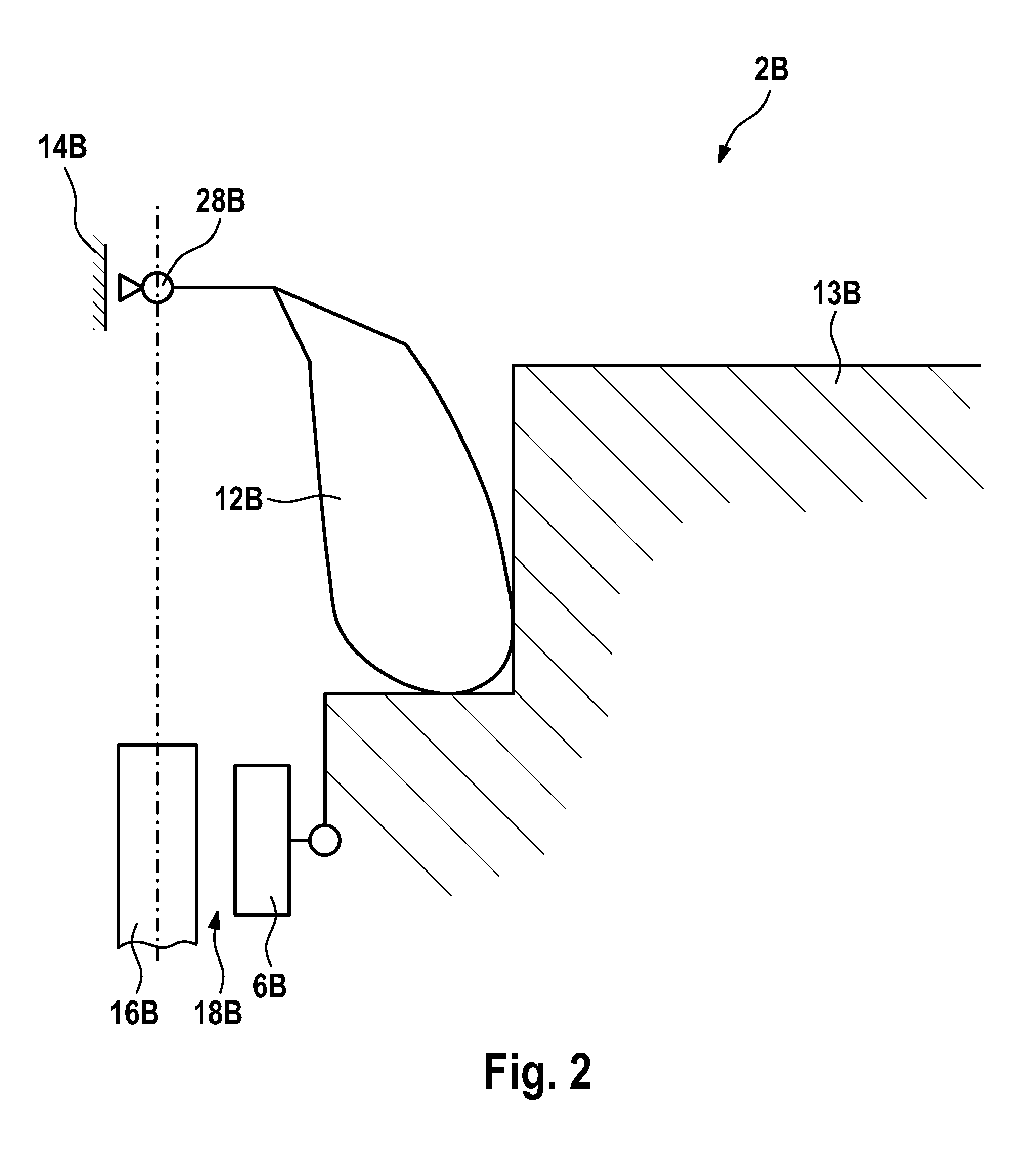Braking Device for Braking a Lift Car
- Summary
- Abstract
- Description
- Claims
- Application Information
AI Technical Summary
Benefits of technology
Problems solved by technology
Method used
Image
Examples
first embodiment
[0091]a braking device 2A for braking a lift car which is schematically illustrated from above in FIG. 1 includes a catch 4A and two braking modules 6A configured as brake shoes which are connected to a common counterpart 8A, wherein this counterpart 8A is in contact with the catch 4A in the operating position shown in FIG. 1. It is provided that the lift car can carry out a movement along a rail 16A as a device. In the context of the present invention, the term “lift car” denotes any kind of “vehicle” for the transport of loads or persons moving relative to a lift shaft.
[0092]In this first operating situation, both braking modules 6A are distanced from the rail 16A with formation of two symmetric release gaps 18A by a spring 10A and two levers 12A which are each supported by fulcrums 28A at a wall structure 14A.
[0093]In this first operating position, it is further provided that an electromagnet 20A pulls the catch 4A upwards (i.e. against gravity). This measure allows to connect th...
fifth embodiment
[0104]FIG. 5 shows a schematic view of a braking device 2E having a catch mechanism which is designed for tensile forces.
[0105]This fifth embodiment of the braking device 2E includes a catch 4E having an arm 24E at the end of which an arc 30E is disposed which has a sphere 32E at one end. The arm 24E of the catch 4E is displacibly and rotatably mounted relative to a wall structure 14E by a fulcrum 28E. At the wall structure 14E also an electromagnet 20E is mounted through which a current is flowing in the operating position shown in FIG. 5 so that it pulls the catch 4E upwards. By another fulcrum 29E, a counterpart 8E of a braking module 6E which in this case has a brake pad 34E is rotatably mounted relative to the wall structure 14E. A spring 10E is compressed between the wall structure 14E and the braking module 6E. The spring 10E is prevented from pressing the braking module 6E to the right by the fact that the catch 4E is connected to the counterpart 8E of the braking module and...
sixth embodiment
[0107]FIG. 6 shows a braking device 2F in three different operating positions, i.e. a first variant of a first operating position 36F in an upper portion of FIG. 6, a second variant of a first operating position 360F in a middle portion of FIG. 6, and an embodiment of a second operating position 38F in a lower portion of FIG. 6.
[0108]FIG. 6 shows a sixth embodiment of a braking device in three operating positions 36F, 360F, 38F of a catch 4F and resulting operating positions of a braking module 6F. In detail, the braking device 2F comprises a catch 4F having an arm 24F, an arc 30F and a sphere 32F, wall structures 14F and furthermore the braking module 6F having a counterpart 8F and a brake pad 34F. In this context, a spring 10F is tensioned between the braking module 6F and one of the wall structures 14F. Moreover, FIG. 6 shows a stationary device designed as a rail 16F and electromagnets 20F. FIG. 6 also shows a catching aid 40F configured as a path having an inclined plane.
[0109]...
PUM
 Login to View More
Login to View More Abstract
Description
Claims
Application Information
 Login to View More
Login to View More - R&D
- Intellectual Property
- Life Sciences
- Materials
- Tech Scout
- Unparalleled Data Quality
- Higher Quality Content
- 60% Fewer Hallucinations
Browse by: Latest US Patents, China's latest patents, Technical Efficacy Thesaurus, Application Domain, Technology Topic, Popular Technical Reports.
© 2025 PatSnap. All rights reserved.Legal|Privacy policy|Modern Slavery Act Transparency Statement|Sitemap|About US| Contact US: help@patsnap.com



